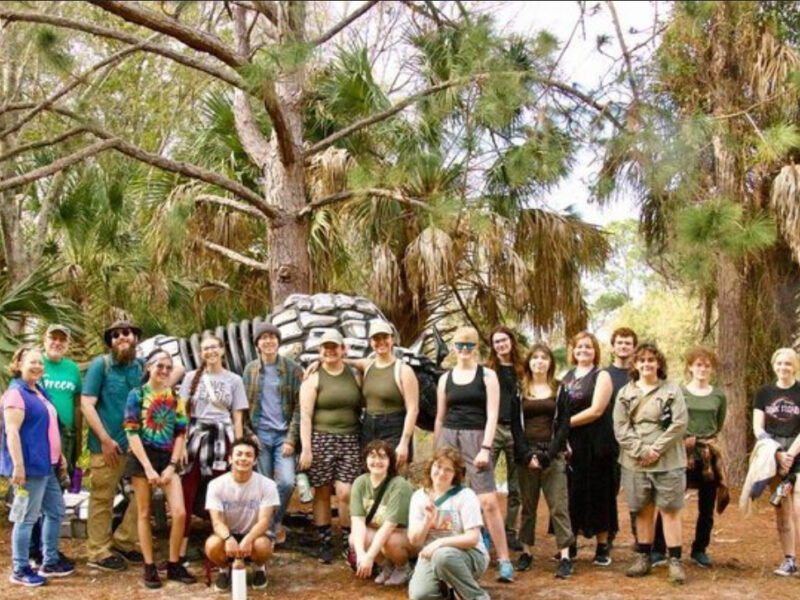Arsenault toured the U.S. in promotion of the book for two months and appeared on PBS NewsHour, National Public Radio and ESPN Radio. Dinorah Prevost | The Crow’s Nest
By Dinorah Prevost
Ray Arsenault calls his latest book a “roach killer.”
It’s hardcover and 784 pages thick. If dropped on a roach, the book’s weight would crush it flat.
“Not just a book to read, it’s to control your roach population,” said the longtime USF St. Petersburg history professor.
The book, “Arthur Ashe: A Life,” is a biography of famed tennis player Arthur Ashe, an influential African-American player of the 20th century who passed away 25 years ago.
Arsenault’s book is the first comprehensive write-up of Ashe’s life.
For over a month, Arsenault toured the U.S. promoting the book. The Nelson Poynter Memorial Library hosted his first book talk on Wednesday since his return to St. Petersburg.
“I look so jet-lagged. I’ve been traveling all over the country, lecturing about him (Ashe), doing book signings, radio, TV interviews,” Arsenault said.
Days before Wednesday’s talk, he spoke to a class of freshmen at the University of California, Los Angeles, Ashe’s alma mater. The campus’ student health center is named for him.
In August, Arsenault made appearances at the U.S. Open, this year being the 50th anniversary of the tournament’s Open Era. Before the Open Era, only amateur players were allowed to compete in Grand Slam tournaments. Ashe won the first U.S. Open in 1968.
Last month, Arsenault was interviewed for the TV news program PBS NewsHour, National Public Radio’s Morning Edition and the ESPN podcast The Sporting Life with Jeremy Schaap. The New York Times, the Wall Street Journal and other major news publications reviewed the biography.
At 70 years old, Arsenault says this is his last book.
“When I started it, I was pretty sure this would be my last book, or my last book with footnotes,” Arsenault said, referring to the book’s 71 pages of citations. “I want to continue to write, but I think I’ve done my last footnote. Killed enough trees, I think.”
He said his two grandchildren, the second one due in November, will take up his time in the future.

In his 35-year career, he’s written four books and co-edited four others. “Arthur Ashe: A Life” is the last book in a trilogy that Arsenault has written on important figures from the Civil Rights era.
Jim O. Horton, a former George Washington University professor and Arsenault’s friend, inspired the subject of this last book.
“My personal reason for writing this book is my closest friend in graduate school was a man named Jim Horton. Jim was my tennis partner for years. He was a dead ringer for Arthur Ashe. He idolized Ashe, so to be around Jim was to be part of this cult of Arthur Ashe,” Arsenault said.
Horton became ill in 2009 with what was later diagnosed as dementia and passed away in February 2017.
“He didn’t really live to see this book, but it was when Jim was contracting this disease, I decided to write the book. So the book is dedicated to him,” Arsenault said.
Arthur Ashe has history in St. Petersburg from his time as an amateur player. Arsenault recounted an experience he had at a local tennis court.
In March 1969, Ashe played a tennis tournament at the St. Petersburg Tennis Center in Bartlett Park. The tournament was his last as an amateur. He turned professional the next week.
In between matches, Ashe, along with a 15-year-old ball boy, went to practice at the St. Petersburg Country Club. After 90 seconds on the court, a white golfer screamed a racial epithet at him. Ashe choose not to respond and calmly left the court.
Incidents like this, Arsenault said, show Ashe’s character. Arsenault alluded to Ashe’s significant role in the Civil Rights movement.
“With all that’s going on with the controversy over Colin Kaepernick and taking a knee for social justice … I think Ashe comes to mind as a paragon of sportsmanship and civility,” Arsenault said.
“I’m now convinced that he was one of the most heroic figures in American history of the 20th century, and we could certainly use him now.”



